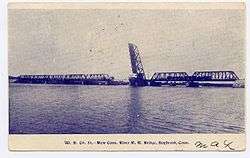Amtrak Old Saybrook – Old Lyme Bridge
| Amtrak Old Saybrook – Old Lyme Bridge | |
|---|---|
 | |
| Coordinates | 41°18′39″N 72°20′57″W / 41.3108°N 72.3492°WCoordinates: 41°18′39″N 72°20′57″W / 41.3108°N 72.3492°W |
| Carries | Northeast Corridor |
| Crosses | Connecticut River |
| Locale | Old Saybrook, Connecticut to Old Lyme, Connecticut |
| Owner | Amtrak |
| Characteristics | |
| Design | Truss bridge with a bascule span |
| Material | Steel |
| Total length | 1,659.6 feet (505.8 m)[1] |
| Longest span | 161 feet (49 m)[1] |
| Number of spans | 9 fixed + 1 bascule[1] |
| Clearance below |
18 feet (5.5 m) (closed) 68 feet (21 m) (open)[2] |
| History | |
| Designer | Scherzer Rolling Lift Bridge Company, Chicago[1] |
| Construction end | 1907 |
| Statistics | |
| Daily traffic |
56 daily trains:[2] 38 Amtrak intercity trains 12 Shore Line East commuter trains 6 P&W freight trains |
 Amtrak Old Saybrook – Old Lyme Bridge Location in Connecticut | |
The Amtrak Old Saybrook – Old Lyme Bridge is the last crossing of the Connecticut River before it reaches Long Island Sound. It is a Truss bridge with a bascule span, allowing boat traffic to go through. Its tracks are owned by Amtrak and used by trains on their Northeast Corridor and Shore Line East high-speed rail lines. It can be seen from the Raymond E. Baldwin Bridge (Interstate 95 and U.S. Route 1), as well as from various points on Route 154.
Construction and operational history

Also known as the Connecticut River Railroad Bridge and Connecticut River Bridge, it was built in 1907 by the Scherzer Rolling Lift Bridge Company of Chicago, for the New York, New Haven and Hartford Railroad. It replaced an earlier bridge, built in 1870.[3] It is similar in design to the Housatonic River Railroad Bridge further south, though shorter in overall length. It also lacks the latter bridge's parallel sets of spans, although the abutments and piers were designed to carry such extra spans (for four total tracks) which were never installed at this location.
The bridge underwent a structural rehabilitation in 1976, and had mechanical and electrical rehabilitation in 1981 and 1997. In 2000 the bridge experienced a major electrical failure which rendered the drawspan stuck in the open position (blocking railroad traffic).[1] The bridge became stuck in the closed position twice in 2001.[4] A 2006 inspection found the bridge to be structurally deficient and determined that periodic rehabilitation work was no longer sufficient to keep the century-old bridge functional.[2]
Historic status designation
The bridge was determined to be eligible for listing on the National Register of Historic Places in 1987, but it was not finally listed due to owner objection, with decision noted in National Register reference number #87002125.[5]
It is one of eight moveable bridges on the Amtrak route through Connecticut surveyed in one multiple property study in 1986.[6] The eight bridges from west to east are: Mianus River Railroad Bridge at Cos Cob, built in 1904; Norwalk River Railroad Bridge at Norwalk, 1896; Saugatuck River Railroad Bridge at Westport, 1905; Pequonnock River Railroad Bridge at Bridgeport, 1902; Housatonic River Railroad Bridge, at Devon, 1905; this Connecticut River Railroad Bridge, Old Saybrook-Old Lyme, 1907; Niantic River Bridge, East Lyme-Waterford, 1907; and Thames River Bridge (Amtrak), Groton, built in 1919.
Replacement
The structurally deficient bridge is planned for replacement around 2020. An Environmental Assessment released in May 2014 identified two preferred alternatives: a bascule bridge similar in size to the existing span, or a vertical lift bridge with possibly increased clearances. Either option would be built on a parallel alignment 48 feet (15 m) south of the existing bridge. Fully high-level designs without movable sections were eliminated from consideration due to the massive approaches that would have to be built, which would have major impacts on nearby wetlands and increase construction and land acquisition costs.[2]
See also
References
- 1 2 3 4 5 Paul X. O'Neill, Jr., Alex Ostrovsky (2002). "Failure and Quick Recovery of Movable Bridge on the Acela Line." Technical paper presented at 9th Biennial Movable Bridge Symposium, Daytona Beach, FL, sponsored by Heavy Movable Structures, Inc.
- 1 2 3 4 "Connecticut River Bridge Replacement Project: Environmental Assessment & Section 4(f) Evaluation". Federal Railroad Administration. 28 May 2014. Retrieved 14 April 2016.
- ↑ Karr, Ronald Dale (1995). The Rail Lines of Southern New England. Branch Line Press. p. 95. ISBN 0942147022.
- ↑ Overton, Penelope (2001-08-24). "Aging Bridge Causes Delays". Hartford Courant.
- ↑ National Park Service (2009-03-13). "National Register Information System". National Register of Historic Places. National Park Service.
- ↑ Bruce Clouette, Matthew Roth and John Herzan (February 4, 1986). "Movable Railroad Bridges on the NE Corridor in Connecticut TR" (PDF). National Park Service. National Register of Historic Places Inventory-Nomination Form.
External links
| Wikimedia Commons has media related to Category:Amtrak Old Saybrook – Old Lyme Bridge. |